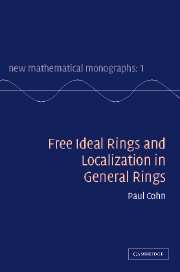Larry Smith / West Virginia University
Dagmar Meyer / Uniwersytet Wroclawski, Poland
Poincare Duality Algebras, Macaulay's Dual Systems, and
Steenrod Operations
Series: Cambridge Tracts in Mathematics (No. 167)
Hardback ISBN 0521850649
Not yet published - available from May 2005 (Stock level updated:
17:58 GMT, 18 January 2005)
Poincare duality algebras originated in the work of topologists
on the cohomology of closed manifolds, and Macaulay's dual
systems in the study of irreducible ideals in polynomial algebras.
These two ideas are tied together using basic commutative algebra
involving Gorenstein algebras. Steenrod operations also
originated in algebraic topology, but may best be viewed as a
means of encoding the information often hidden behind the
Frobenius map in characteristic p<>0. They provide a
noncommutative tool to study commutative algebras over a Galois
field. In this Tract the authors skilfully bring together these
ideas and apply them to problems in invariant theory. A number of
remarkable and unexpected interdisciplinary connections are
revealed that will interest researchers in the areas of
commutative algebra, invariant theory or algebraic topology.
Contents
Introduction; Part I. Poincare Duality Quotients; Part II.
Macaulayfs Dual Systems and Frobenius Powers; Part III.
Poincare Duality and the Steenrod Algebra; Part IV. Dickson,
Symmetric, and other Coinvariants; Part V. The Hit Problem mod 2;
Part VI. Macaulayfs Inverse Systems and Applications;
References; Notation; Index.
Ke Chen
University of Liverpool
Matrix Preconditioning Techniques and Applications
Series: Cambridge Monographs on Applied and Computational
Mathematics
Hardback ISBN 0521838282
Not yet published - available from July 2005
Preconditioning techniques have emerged as an essential part of
successful and efficient iterative solutions of matrices. Ke Chenfs
book offers a comprehensive introduction to these methods. A vast
range of explicit and implicit sparse preconditioners are
covered, including the conjugate gradient, multi-level and fast
multi-pole methods, matrix and operator splitting, fast Fourier
and wavelet transforms, incomplete LU and domain decomposition,
Schur complements and approximate inverses. In addition, aspects
of parallel realization using the MPI are discussed. Very much a
users-guide, the book provides insight to the use of these
techniques in areas such as acoustic wave scattering, image
restoration and bifurcation problems in electrical power stations.
Supporting MATLAB files are available from the Web to support and
develop readersf understanding, and provide stimulus for
further study. Pitched at graduate level, the book is intended to
serve as a useful guide and reference for students, computational
practitioners, engineers and researchers alike.
Contents
1. Introduction; 2. Direct methods; 3. Iterative methods; 4.
Matrix splitting preconditioners [t1]; 5. Approxi,ate inverse
preconditioners [t2]; 6. Multilevel methods and preconditioners [t3];
7. Multilevel recursive Schur complements preconditioners; 8.
Wavelet preconditioners [t5] for ?A n x n and ?A -1 n x n; 9.
Wavelet Schur preconditioners [t6]; 10. Implicit wavelet
preconditioners [t7]; 11. Application I - acoustic scattering
modelling; 12. Application II - coupled matrix problems; 13.
Application III - image restoration and inverse problems; 14.
Application IV-voltage stability in electrical power systems; 15.
Parallel computing by examples.
Kyriakos Tamvakis
University of Ioannina, Greece
Problems and Solutions in Quantum Mechanics
Hardback ISBN 0521840872
PaperbackISBN 052160057X
Not yet published - available from September 2005
Textbook
Lecturers can request inspection copies of this title.
Courses: Quantum Mechanics Modern Physics Theoretical Physics
This collection of solved problems corresponds to the standard
topics covered in established undergraduate and graduate courses
in Quantum Mechanics. Completely up-to-date, problems are also
included on topics of current interest which are absent in the
existing literature. Solutions are presented in considerable
detail, to enable students to follow each step. The emphasis is
on stressing the principles and methods used, allowing students
to master new ways of thinking and problem-solving techniques.
The problems themselves are longer than those usually encountered
in textbooks and consist of a number of questions based around a
central theme, highlighting properties and concepts of interest.
For undergraduate and graduate students, as well as those
involved in teaching Quantum Mechanics, the book can be used as a
supplementary text or as an independent self-study tool.
Contents
1. Wave functions; 2. The free particle; 3. Simple potentials; 4.
The harmonic oscillator; 5. Angular momentum; 6. Quantum
behaviour; 7. General motion; 8. Many particle systems; 9.
Approximation methods; 10. Scattering.
Paul Cohn
University College London
Free Ideal Rings and Localization in General Rings
 Series: Encyclopedia of Mathematics and its Applications
Series: Encyclopedia of Mathematics and its Applications
Hardback ISBN 0521853370
Not yet published - available from October 2005
Proving that a polynomial ring in one variable over a field is a
principal ideal domain can be done by means of the Euclidean
algorithm, but this does not extend to more variables. However,
if the variables are not allowed to commute, giving a free
associative algebra, then there is a generalization, the weak
algorithm, which can be used to prove that all one-sided ideals
are free. This book presents the theory of free ideal rings (firs)
in detail. Particular emphasis is placed on rings with a weak
algorithm, exemplified by free associative algebras. There is
also a full account of localization which is treated for general
rings but the features arising in firs are given special
attention. Each section has a number of exercises, including some
open problems, and each chapter ends in a historical note.
Contents
Preface; Note to the reader; Terminology, notations and
conventions used; List of special notation; 0. Preliminaries in
modules; 1. Principal ideal domains; 2. Firs, semifirs and the
weak algorithm; 3. Factorization; 4. 2-firs with a distributive
factor lattice; 5. Modules over firs and semifirs; 6.
Centralizers and subalgebras; 7. Skew fields of fractions;
Appendix; Bibliography and author index; Subject index.
 Series: Encyclopedia of Mathematics and its Applications
Series: Encyclopedia of Mathematics and its Applications